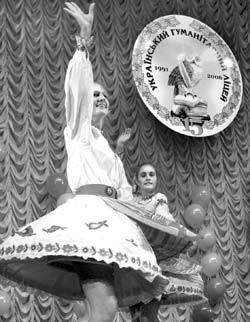Contemporary of Ukraine’s independence
The Humanities Lyceum at Shevchenko University marks its 15th anniversary
The Humanities Lyceum does not have a number. Its director, Merited Pedagogue of Ukraine Halyna Sazonenko, thinks that the school should be recognized by the name of its head rather than by its name. Perhaps owing to this conviction, this lyceum is considered one of the Ukrainian capital’s top 10 schools.
This educational establishment recently marked its 15th anniversary. The date is significant. The lyceum has experienced much travail, and several generations of pupils have graduated from the school. But in order to progress and not rest on our achievements, the problem of Ukrainian lyceums must be broached.
These are not the best of times for Ukrainian lyceums. It is therefore no surprise that the conference “Lyceum Education in Ukraine: the European Dimension,” which was pegged to the school’s anniversary, caused a stir among the directors of lyceums and structural subdivisions of various universities.
“Right now it is crucial to look into the normative legal base and the non-correlation among forms of property,” Sazonenko explains. It turns out that lyceums in Ukraine are only municipal and private. There are nearly 150 private educational establishments in Kyiv alone. Municipal lyceums are subordinated to municipal raion administrations and obtain corresponding financing. Directors of lyceums think that such educational establishments should be state-owned, like all higher educational institutions.
Another question is that the Scholarly-Research Institute at the Academy of Pedagogical Sciences of Ukraine does not conduct any monitoring of the educational content of lyceums, and a concept of the development of such educational establishments has still not been drafted. Also unresolved are problems of financing lyceums, which require an individual staff schedule and proper technical base.
“Lyceums used to be the leading educational establishments in the history of pedagogy,” Sazonenko explains. “They always prepared professionals for state service. But in Soviet times all schools were supposed to be secondary ones, and this is what they were called. The worst thing was, if a child possessed higher than average abilities, s/he was immediately dragged down.”
In Sazonenko’s opinion, starting in 1991, “when we got a taste of freedom,” gymnasiums, lyceums, and collegiums began to revive. “These educational establishments are characteristic of Ukrainian pedagogy, and today they are the strongest and most unique. The lyceums work with talented youth and discover talents and aptitudes.”
At the same time, pedagogues say that the role of secondary schools should not be diminished, because they too need the state’s support. “Each of us has his own unique task,” Sazonenko says. In France, for example, lyceums are considered to be profile educational establishments. “Children are given their first professional skills there. Our traditions are completely different, and in my opinion, it would be wrong to turn lyceums, which have prepared pupils on the state level, into professional schools,” the director of the Humanities Lyceum said.
There were a lot of gifts and greetings exchanged during the celebrations of the lyceum’s 15th anniversary. Practically all the members of the Board of Guardians attended, including its head, Leonid Kravchuk. The top students were presented with copies of the book My Universities by Larysa Ivshyna, The Day’s editor in chief.






